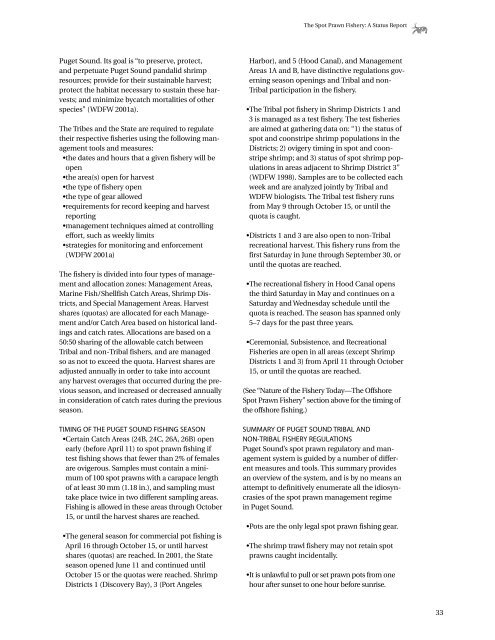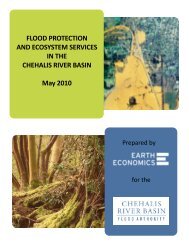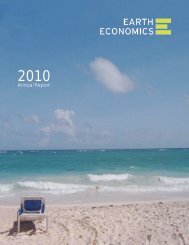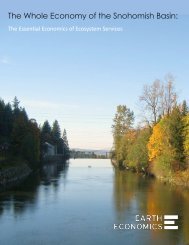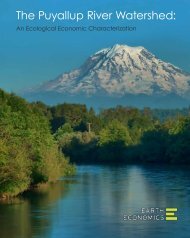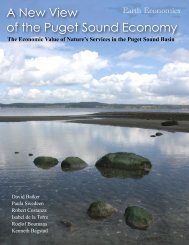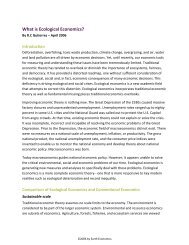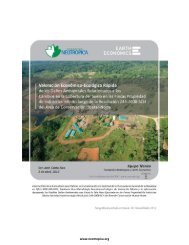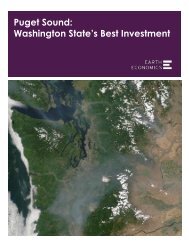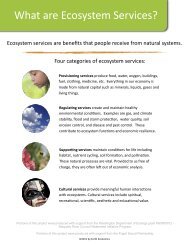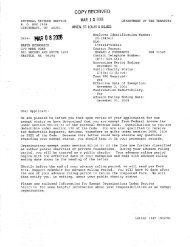The Spot Prawn Fishery: A Status Report - Earth Economics
The Spot Prawn Fishery: A Status Report - Earth Economics
The Spot Prawn Fishery: A Status Report - Earth Economics
Create successful ePaper yourself
Turn your PDF publications into a flip-book with our unique Google optimized e-Paper software.
<strong>The</strong> <strong>Spot</strong> <strong>Prawn</strong> <strong>Fishery</strong>: A <strong>Status</strong> <strong>Report</strong><br />
Puget Sound. Its goal is “to preserve, protect,<br />
and perpetuate Puget Sound pandalid shrimp<br />
resources; provide for their sustainable harvest;<br />
protect the habitat necessary to sustain these harvests;<br />
and minimize bycatch mortalities of other<br />
species” (WDFW 2001a).<br />
<strong>The</strong> Tribes and the State are required to regulate<br />
their respective fisheries using the following management<br />
tools and measures:<br />
•the dates and hours that a given fishery will be<br />
open<br />
•the area(s) open for harvest<br />
•the type of fishery open<br />
•the type of gear allowed<br />
•requirements for record keeping and harvest<br />
reporting<br />
•management techniques aimed at controlling<br />
effort, such as weekly limits<br />
•strategies for monitoring and enforcement<br />
(WDFW 2001a)<br />
<strong>The</strong> fishery is divided into four types of management<br />
and allocation zones: Management Areas,<br />
Marine Fish/Shellfish Catch Areas, Shrimp Districts,<br />
and Special Management Areas. Harvest<br />
shares (quotas) are allocated for each Management<br />
and/or Catch Area based on historical landings<br />
and catch rates. Allocations are based on a<br />
50:50 sharing of the allowable catch between<br />
Tribal and non-Tribal fishers, and are managed<br />
so as not to exceed the quota. Harvest shares are<br />
adjusted annually in order to take into account<br />
any harvest overages that occurred during the previous<br />
season, and increased or decreased annually<br />
in consideration of catch rates during the previous<br />
season.<br />
TIMING OF THE PUGET SOUND FISHING SEASON<br />
•Certain Catch Areas (24B, 24C, 26A, 26B) open<br />
early (before April 11) to spot prawn fishing if<br />
test fishing shows that fewer than 2% of females<br />
are ovigerous. Samples must contain a minimum<br />
of 100 spot prawns with a carapace length<br />
of at least 30 mm (1.18 in.), and sampling must<br />
take place twice in two different sampling areas.<br />
Fishing is allowed in these areas through October<br />
15, or until the harvest shares are reached.<br />
•<strong>The</strong> general season for commercial pot fishing is<br />
April 16 through October 15, or until harvest<br />
shares (quotas) are reached. In 2001, the State<br />
season opened June 11 and continued until<br />
October 15 or the quotas were reached. Shrimp<br />
Districts 1 (Discovery Bay), 3 (Port Angeles<br />
Harbor), and 5 (Hood Canal), and Management<br />
Areas 1A and B, have distinctive regulations governing<br />
season openings and Tribal and non-<br />
Tribal participation in the fishery.<br />
•<strong>The</strong> Tribal pot fishery in Shrimp Districts 1 and<br />
3 is managed as a test fishery. <strong>The</strong> test fisheries<br />
are aimed at gathering data on: “1) the status of<br />
spot and coonstripe shrimp populations in the<br />
Districts; 2) ovigery timing in spot and coonstripe<br />
shrimp; and 3) status of spot shrimp populations<br />
in areas adjacent to Shrimp District 3”<br />
(WDFW 1998). Samples are to be collected each<br />
week and are analyzed jointly by Tribal and<br />
WDFW biologists. <strong>The</strong> Tribal test fishery runs<br />
from May 9 through October 15, or until the<br />
quota is caught.<br />
•Districts 1 and 3 are also open to non-Tribal<br />
recreational harvest. This fishery runs from the<br />
first Saturday in June through September 30, or<br />
until the quotas are reached.<br />
•<strong>The</strong> recreational fishery in Hood Canal opens<br />
the third Saturday in May and continues on a<br />
Saturday and Wednesday schedule until the<br />
quota is reached. <strong>The</strong> season has spanned only<br />
5–7 days for the past three years.<br />
•Ceremonial, Subsistence, and Recreational<br />
Fisheries are open in all areas (except Shrimp<br />
Districts 1 and 3) from April 11 through October<br />
15, or until the quotas are reached.<br />
(See “Nature of the <strong>Fishery</strong> Today—<strong>The</strong> Offshore<br />
<strong>Spot</strong> <strong>Prawn</strong> <strong>Fishery</strong>” section above for the timing of<br />
the offshore fishing.)<br />
SUMMARY OF PUGET SOUND TRIBAL AND<br />
NON-TRIBAL FISHERY REGULATIONS<br />
Puget Sound’s spot prawn regulatory and management<br />
system is guided by a number of different<br />
measures and tools. This summary provides<br />
an overview of the system, and is by no means an<br />
attempt to definitively enumerate all the idiosyncrasies<br />
of the spot prawn management regime<br />
in Puget Sound.<br />
•Pots are the only legal spot prawn fishing gear.<br />
•<strong>The</strong> shrimp trawl fishery may not retain spot<br />
prawns caught incidentally.<br />
•It is unlawful to pull or set prawn pots from one<br />
hour after sunset to one hour before sunrise.<br />
33


